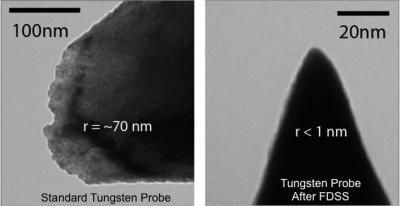Researchers led by Professor Joseph Lyding at the University of Illinois have devised a new technique to sharpen microscopic probes that significantly enhances image resolution. Probes are essential components of microscopes widely used to study structures of atomic scale where the tip of the probe is used to scan the sample surface to determine its chemical, electrical and mechanical properties.
 This is a traditionally etched tungsten STM probe (left), sharpened to a 1-nanometer point after bombarding it with ions (right). Credit: Joseph Lyding
This is a traditionally etched tungsten STM probe (left), sharpened to a 1-nanometer point after bombarding it with ions (right). Credit: Joseph Lyding
The quality of data depends on the condition of the probe. Probes deteriorate with use and a worn out probe provides poor resolution. Lyding compares a degraded probe in an expensive microscope like scanning tunneling microscope (STM) or an atomic force microscope (AFM) to employing bicycle tires in an expensive racecar.
Conventional techniques to sharpen probe involve bombardment of the tip with a stream of ions that cause the probe material to sputter off. During one such probe sharpening exercise, Lyding decided to apply an equivalent voltage to the tip to ward off the incoming stream of ions. Electric field is stronger around sharp objects. So the maximum deflection of ions was at the tips which resulted in the removal of material around the tip while keeping the tip intact otherwise.
Lyding’s team demonstrated the process by using an ion gun and was able to sharpen a 100 nm STM probe to 1 nm. In order to prevent further deterioration of the sharpened probe, the team applied a coating of hafnium diboride commonly used for silicon semiconductors. The metallic coating paved the way for durable and stable probes. The researchers have received a patent for their new and improved probes and are ready to commercialize the same.
Source: http://illinois.edu/